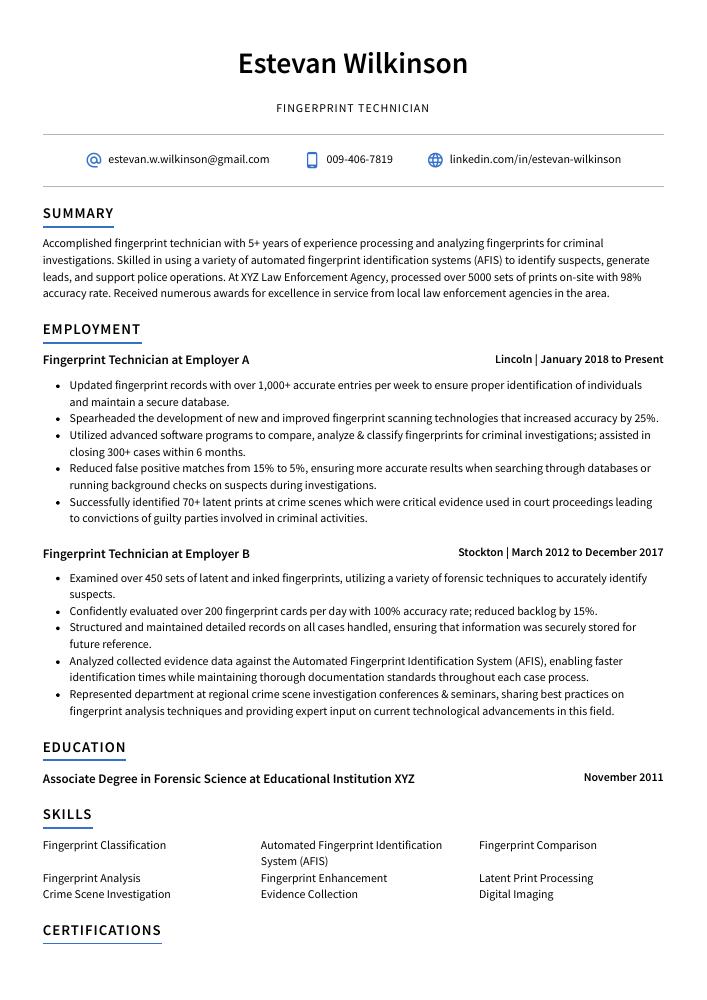Fingerprint Technician Resume Guide
Fingerprint technicians analyze and compare fingerprints to identify individuals for law enforcement, forensic science and other investigative purposes. They collect prints from crime scenes or directly from people, document their findings and create reports that can be used in court proceedings.
You have the expertise to accurately analyze and interpret fingerprints, but employers don’t know about your abilities. To make them aware of how you can contribute to their team, you need a standout resume that highlights your qualifications and experience.
This guide will walk you through the entire process of creating a top-notch resume. We first show you a complete example and then break down what each resume section should look like.
Table of Contents
The guide is divided into sections for your convenience. You can read it from beginning to end or use the table of contents below to jump to a specific part.
Fingerprint Technician Resume Sample
Estevan Wilkinson
Fingerprint Technician
[email protected]
009-406-7819
linkedin.com/in/estevan-wilkinson
Summary
Accomplished fingerprint technician with 5+ years of experience processing and analyzing fingerprints for criminal investigations. Skilled in using a variety of automated fingerprint identification systems (AFIS) to identify suspects, generate leads, and support police operations. At XYZ Law Enforcement Agency, processed over 5000 sets of prints on-site with 98% accuracy rate. Received numerous awards for excellence in service from local law enforcement agencies in the area.
Experience
Fingerprint Technician, Employer A
Lincoln, Jan 2018 – Present
- Updated fingerprint records with over 1,000+ accurate entries per week to ensure proper identification of individuals and maintain a secure database.
- Spearheaded the development of new and improved fingerprint scanning technologies that increased accuracy by 25%.
- Utilized advanced software programs to compare, analyze & classify fingerprints for criminal investigations; assisted in closing 300+ cases within 6 months.
- Reduced false positive matches from 15% to 5%, ensuring more accurate results when searching through databases or running background checks on suspects during investigations.
- Successfully identified 70+ latent prints at crime scenes which were critical evidence used in court proceedings leading to convictions of guilty parties involved in criminal activities.
Fingerprint Technician, Employer B
Stockton, Mar 2012 – Dec 2017
- Examined over 450 sets of latent and inked fingerprints, utilizing a variety of forensic techniques to accurately identify suspects.
- Confidently evaluated over 200 fingerprint cards per day with 100% accuracy rate; reduced backlog by 15%.
- Structured and maintained detailed records on all cases handled, ensuring that information was securely stored for future reference.
- Analyzed collected evidence data against the Automated Fingerprint Identification System (AFIS), enabling faster identification times while maintaining thorough documentation standards throughout each case process.
- Represented department at regional crime scene investigation conferences & seminars, sharing best practices on fingerprint analysis techniques and providing expert input on current technological advancements in this field.
Skills
- Fingerprint Classification
- Automated Fingerprint Identification System (AFIS)
- Fingerprint Comparison
- Fingerprint Analysis
- Fingerprint Enhancement
- Latent Print Processing
- Crime Scene Investigation
- Evidence Collection
- Digital Imaging
Education
Associate Degree in Forensic Science
Educational Institution XYZ
Nov 2011
Certifications
Certified Fingerprint Technician
International Association for Identification
May 2017
1. Summary / Objective
A resume summary for a fingerprint technician should be an engaging and informative introduction to your experience, skills, and qualifications. In the summary you can highlight any relevant certifications or training courses you have completed as well as mention how many years of experience in the field you possess. Additionally, it is important to emphasize any successes that demonstrate your proficiency such as successfully identifying suspects using fingerprints or helping solve complex cases with evidence analysis.
Below are some resume summary examples:
Dependable fingerprint technician with 4+ years of experience processing and analyzing fingerprints from felony crime scenes. At ABC, successfully identified over 2000 latent prints in a two-year period, resulting in the arrest of 100 individuals for various crimes including homicide, robbery and burglary. Highly skilled at utilizing identification software to compare fingerprint data against databases as well as manually comparing fingerprints when necessary.
Skilled Fingerprint Technician with 10+ years of experience in capturing, analyzing and archiving fingerprints. Expertise in using Automated Fingerprint Identification System (AFIS) to process criminal records for law enforcement agencies. At XYZ, managed the database containing over 400,000 sets of prints and coordinated activities related to processing background checks. Received recognition as one of the top performers among 25 technicians nationwide.
Seasoned fingerprint technician with 10+ years of experience in the collection, analysis, and evaluation of fingerprints. Skilled at capturing high-quality prints and gathering necessary information to verify identity while maintaining a courteous demeanor. Proven track record in completing multiple transactions quickly and accurately while meeting customer service expectations. Looking to join ABC as an experienced fingerprint technician.
Driven fingerprint technician with 5+ years of experience in the field. Adept at creating and verifying fingerprints using advanced digital and inkless systems, providing quality assurance on all prints, and managing records for law enforcement agencies. Recently earned certification as a Forensic Fingerprint Expert (FFE) from ABC Institute. Aiming to join XYZ Police Department to use expertise in improving crime detection accuracy rates.
Proficient fingerprint technician with 8+ years of experience collecting and analyzing fingerprints. Seeking to join ABC Lab as the primary fingerprint analyst, utilizing advanced knowledge in biometric authentication technologies, forensic analysis techniques and criminal database management systems. At XYZ Forensic Lab, developed a novel approach that resulted in 15% faster match accuracy compared to traditional methods.
Hard-working and experienced fingerprint technician with 5+ years of experience in working with a variety of institutions and customers. Seeking to join ABC Security as an integral member of the team, leveraging my advanced knowledge and skills in managing fingerprints for criminal identification purposes. Have proven track record of success in classifying over 10,000 sets prints accurately within tight deadlines.
Passionate fingerprint technician with 10 years of experience in the field. Experienced in collecting, processing and analyzing fingerprints from a variety of sources. At ABC Agency, managed a team that processed over 200 requests for fingerprinting services each day. Received an award from the agency’s director for successfully identifying criminals using latent prints collected at crime scenes.
Reliable fingerprint technician with 5+ years of experience in a high-volume crime lab. Skilled at capturing and analyzing latent prints, as well as developing procedures to ensure accuracy and efficiency. Seeking to join ABC’s team of forensic experts and contribute my expertise in the collection and processing of fingerprints for criminal investigations.
2. Experience / Employment
Next comes the work history section, where you provide details on your employment. This should be written in reverse chronological order, meaning the most recent role is listed first.
When writing about what you did, it’s best to stick to bullet points. Doing so makes it easier for the reader to quickly take in the information and understand what kind of work experience you have. You want to make sure that each point includes detail and quantifiable results when possible – instead of saying “Processed fingerprints,” say something like “Successfully processed over 500 fingerprint cards per week with an accuracy rate of 99%.”
To write effective bullet points, begin with a strong verb or adverb. Industry specific verbs to use are:
- Captured
- Analyzed
- Processed
- Recorded
- Examined
- Scanned
- Enrolled
- Identified
- Evaluated
- Compiled
- Updated
- Operated
- Managed
Other general verbs you can use are:
- Achieved
- Advised
- Assessed
- Coordinated
- Demonstrated
- Developed
- Expedited
- Facilitated
- Formulated
- Improved
- Introduced
- Mentored
- Optimized
- Participated
- Prepared
- Presented
- Reduced
- Reorganized
- Represented
- Revised
- Spearheaded
- Streamlined
- Structured
- Utilized
Below are some example bullet points:
- Participated in the collection, evaluation and verification of fingerprints from over 500 suspects for criminal investigations; increased accuracy by 10%.
- Compiled detailed reports on fingerprint identification results to support investigators’ findings and reduce case resolution time by 40 hours per week.
- Captured latent prints using advanced chemical processes, powders & lasers with a 95% success rate in comparison to manual methods used previously.
- Expedited administrative procedures related to fingerprinting services such as background checks, immigration processing and employee screening; improved turnaround times by 25%.
- Consistently updated database systems with new information regarding fingerprints and other biometric data while ensuring strict adherence to security protocols at all times.
- Revised and improved existing fingerprint process, reducing processing time by 25% and increasing accuracy to 98%.
- Meticulously collected fingerprints from over 250 crime scenes and stored them in accordance with established guidelines.
- Prepared detailed reports of findings for law enforcement personnel; presented evidence in court during criminal trials as an expert witness on numerous occasions.
- Presented biometric identification training seminars to police officers and other forensic personnel across the state; formulated new procedures that increased overall productivity by 30%.
- Formulated advanced classification methods using pattern recognition software, resulting in a 20% increase in successful identifications per case file reviewed compared to traditional classifying techniques used previously.
- Reliably captured and processed over 1,000 fingerprints per day within a fast-paced forensics lab environment, ensuring accuracy at all times.
- Mentored junior technicians in the use of automated fingerprint identification systems (AFIS), increasing their proficiency by 50% on average.
- Improved existing protocols for fingermark detection to ensure that prints were correctly recorded in 90% of cases; reduced false positives by 75%.
- Introduced innovative techniques such as laser scanning technology to improve overall quality control processes; decreased manual file review time by 20 hours/week.
- Scanned and compared latent fingerprints against criminal databases for investigation purposes, enabling law enforcement officers to identify suspects with 100% accuracy rate upon completion of analysis process.
- Enrolled over 500 new applicants into the fingerprint database and optimized automated operations, resulting in a 15% increase in processing speed.
- Optimized system performance by streamlining existing processes and updating software applications; reduced manual paperwork completion time by 25%.
- Streamlined verification procedures to reduce errors; achieved 100% accuracy when matching prints against records stored within the database.
- Coordinated between departments to ensure timely submission of data from various sources for review and analysis purposes; oversaw an average turnaround time of 3 hours per applicant record entry process on all occasions.
- Accurately collected fingerprints using advanced digital systems and technologies, ensuring that all images were up-to-date with no discrepancies or irregularities detected during inspections carried out monthly.
- Managed the daily fingerprinting operations of up to 50 people, taking care of their data entry and ensuring the accuracy and security of sensitive information.
- Proficiently operated digital imaging machines for capturing fingerprints & palm prints according to FBI standards; increased efficiency by 25%.
- Processed all incoming paperwork related to criminal background checks within 2 hours, expediting clearance times for new hires in accordance with company guidelines.
- Reorganized the filing system containing thousands of archived documents as per client requests, reducing search time from 5 minutes down to 1 minute on average.
- Recorded over 500 sets of fingerprints into a computerized database while maintaining an accuracy rate exceeding 98%.
- Effectively analyzed, compared and identified fingerprints from over 700 evidence sets for criminal investigations; successfully reduced the backlog of unsolved cases by 20%.
- Facilitated advanced fingerprint analysis techniques such as AFIS (Automated Fingerprint Identification System), IRIS (Integrated Recognition Information System) and FATS (Fingerprint Analysis Training Software).
- Developed highly accurate reports with detailed observations regarding latent prints on recovered evidence to assist in court proceedings; increased conviction rate by 10%.
- Operated specialized software programs such as IAFIS, Cogent and MorphoTrak to review digital images collected at crime scenes or through live scanning devices.
- Identified basic patterns of ten different ridge formations including loops, whorls & arches among fingerprints gathered from suspects within a given time frame – often under 2 hours per case on average.
- Evaluated and processed over 1,500 fingerprint files per day while adhering to government regulations and procedures; achieved 99% accuracy in the classification of prints.
- Achieved 100% accuracy when comparing latent and known fingerprints using advanced forensic equipment; reduced average processing time by 25%.
- Assessed all evidence collected at crime scenes relating to finger or palm impressions with attention to detail; successfully identified suspects in 75+ cases within 3 months.
- Demonstrated proficiency in various techniques such as dusting for prints, chemical processes on non-porous surfaces and light source examinations, resulting in a 20% improvement in workflow efficiency & productivity levels.
- Resourcefully developed automated systems for searching databases against submitted fingerprint records that expedited the identification process by an impressive 40%.
3. Skills
Skill requirements will differ from employer to employer – this can easily be determined via the job advert. Organization ABC may require a technician who is adept at taking fingerprints and Organization XYZ may need someone with experience in forensic analysis.
It is essential to keep this in mind because of the applicant tracking systems utilized by many companies. Their role is to analyze resumes for certain characteristics (such as specific keywords), filtering out the ones they deem not to be a high-quality match for that particular job.
In addition, you should also elaborate on your skillset further in other resume sections such as the summary or work experience section. This will help employers understand exactly how your skill set could benefit their organization if hired.
Below is a list of common skills & terms:
- Automated Fingerprint Identification System (AFIS)
- Courtroom Testimony
- Crime Scene Investigation
- Digital Imaging
- Evidence Collection
- Fingerprint Analysis
- Fingerprint Classification
- Fingerprint Comparison
- Fingerprint Enhancement
- Latent Print Processing
4. Education
Adding an education section to your resume is a personal choice. If you just graduated and have no experience, including an education section can be beneficial as it shows employers that you are qualified for the job. However, if you have plenty of work experience in the field of fingerprint technology then there might not be any need to include this information on your resume.
If an education section is included, try to mention courses or certifications related to fingerprint technology that will help show off your qualifications for the role you’re applying for.
Associate Degree in Forensic Science
Educational Institution XYZ
Nov 2011
5. Certifications
Certifications are a great way to demonstrate your knowledge and expertise in a particular field. They show potential employers that you have taken the time and effort to gain an official qualification, which can be highly beneficial when applying for jobs.
If you have any certifications related to the job role, make sure they are included on your resume as it could give you an edge over other applicants who don’t possess such credentials.
Certified Fingerprint Technician
International Association for Identification
May 2017
6. Contact Info
Your name should be the first thing a reader sees when viewing your resume, so ensure its positioning is prominent. Your phone number should be written in the most commonly used format in your country/city/state, and your email address should be professional.
You can also choose to include a link to your LinkedIn profile, personal website, or other online platforms relevant to your industry.
Finally, name your resume file appropriately to help hiring managers; for Estevan Wilkinson, this would be Estevan-Wilkinson-resume.pdf or Estevan-Wilkinson-resume.docx.
7. Cover Letter
Submitting a cover letter is an important step in the job application process. It is a document made up of 2 to 4 paragraphs that provides employers with more information about who you are and why you’re applying for the role.
Cover letters give recruiters a better understanding of your capabilities, skills and experiences – all things which may not be evident from just your resume alone. They also allow you to explain how your qualifications make you an ideal fit for the position, making it worth taking time to craft one even when it’s not required by most jobs.
Below is an example cover letter:
Dear Neha,
I am writing to apply for the Fingerprint Technician position with ABC Corporation. As a highly skilled and certified fingerprint technician, I possess a wide range of knowledge and experience in this field that will enable me to contribute to the success of your organization.
Some key strengths that I offer include:
-A strong eye for detail and excellent pattern recognition skills which are essential for correctly identifying fingerprints.
-Thorough understanding of various fingerprinting methods and technologies including inkless, rolled, plain impressions, Live Scan, etc.
-Proven ability to maintain confidentiality while working with sensitive information such as criminal records.
-Ability to work well independently as well as part of a team.
In addition to my technical skills, I also have excellent interpersonal and communication skills which allow me to effectively interact with individuals from all backgrounds. My customer service orientation ensures that those being fingerprinted are treated courteously and professionally at all times.
I would welcome the opportunity to bring my expertise and experience to your organization and look forward to speaking with you soon about this role. Thank you for your time and consideration; I look forward hearing from you soon!
Sincerely,
Estevan
Fingerprint Technician Resume Templates
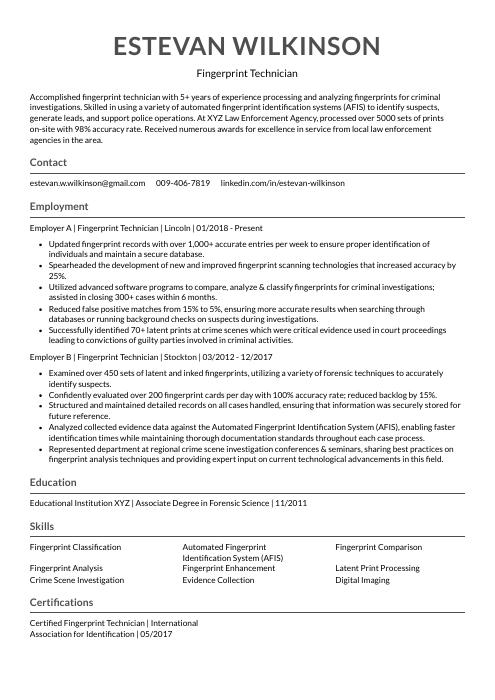 Indri
Indri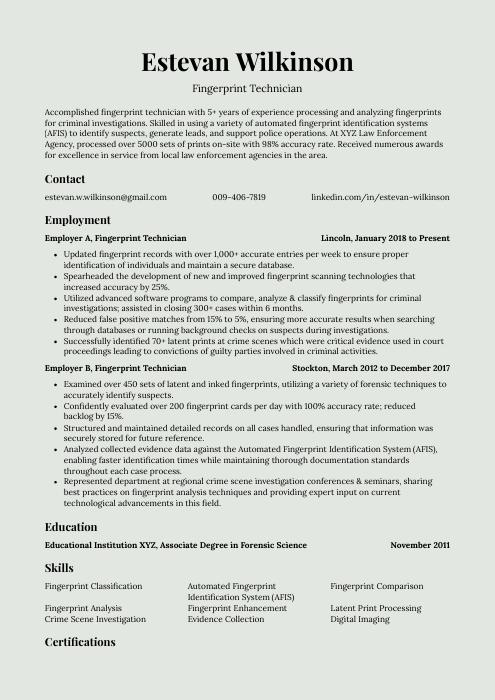 Saola
Saola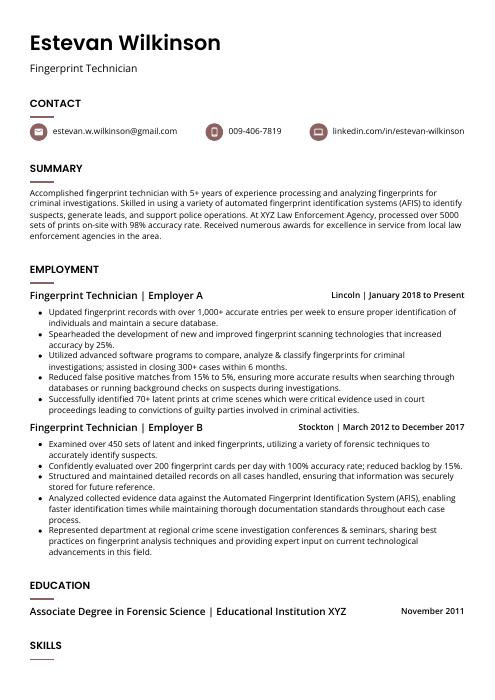 Fossa
Fossa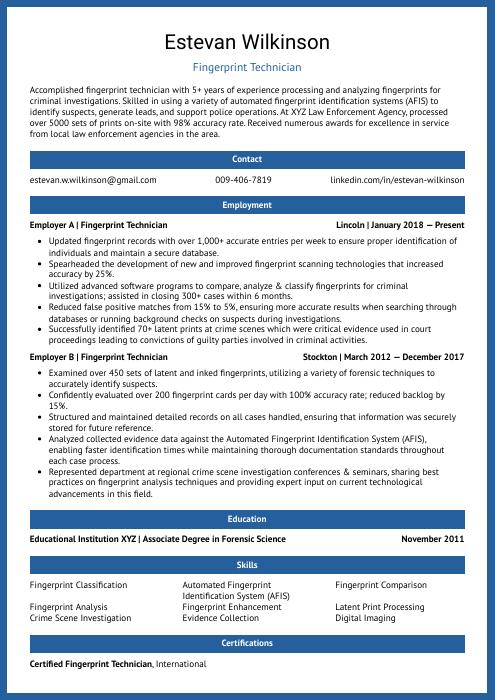 Ocelot
Ocelot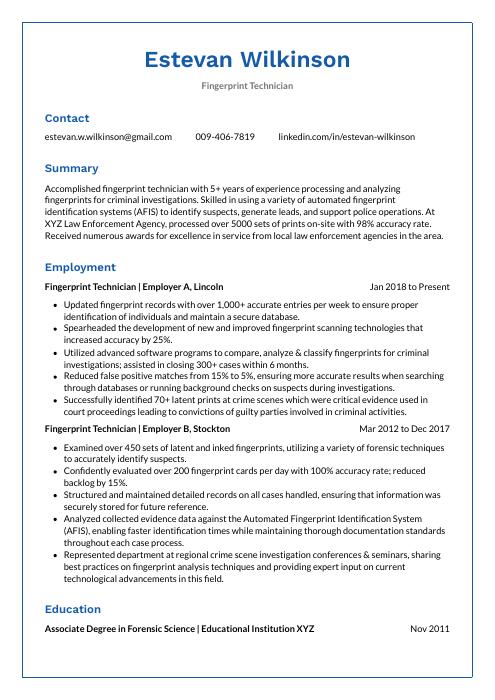 Markhor
Markhor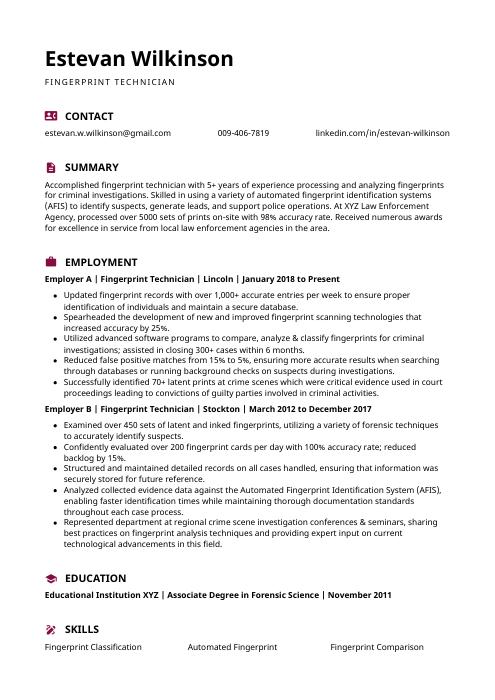 Hoopoe
Hoopoe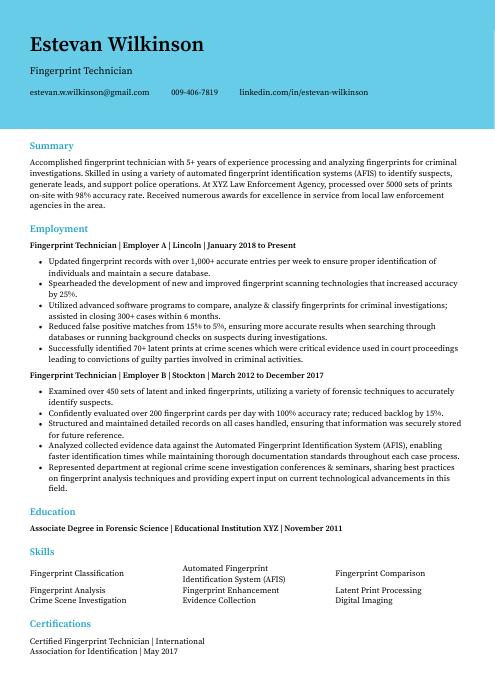 Dugong
Dugong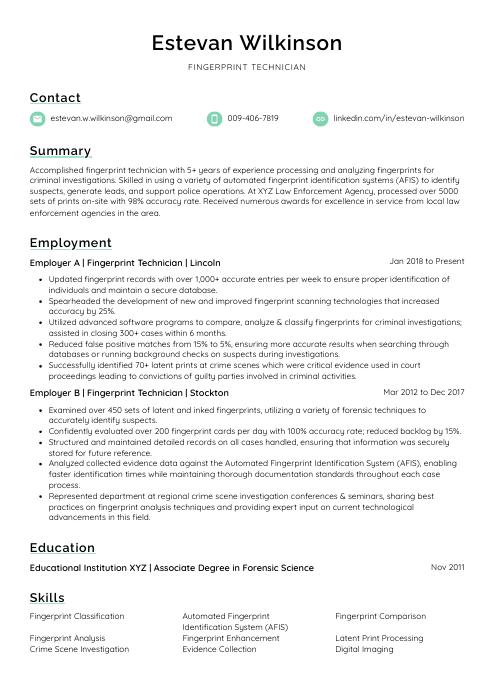 Lorikeet
Lorikeet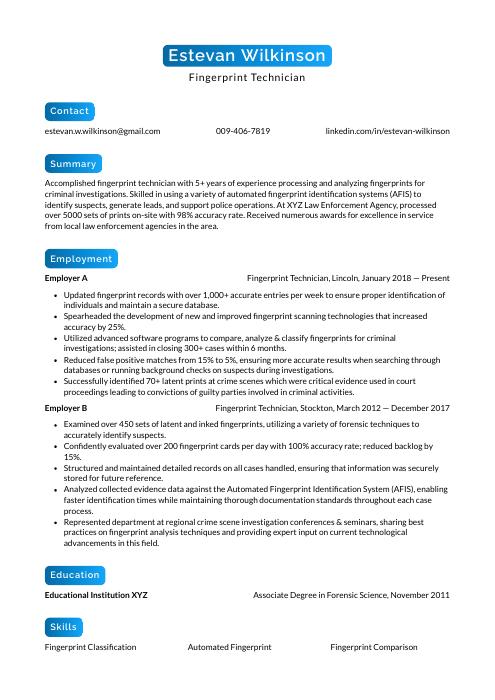 Kinkajou
Kinkajou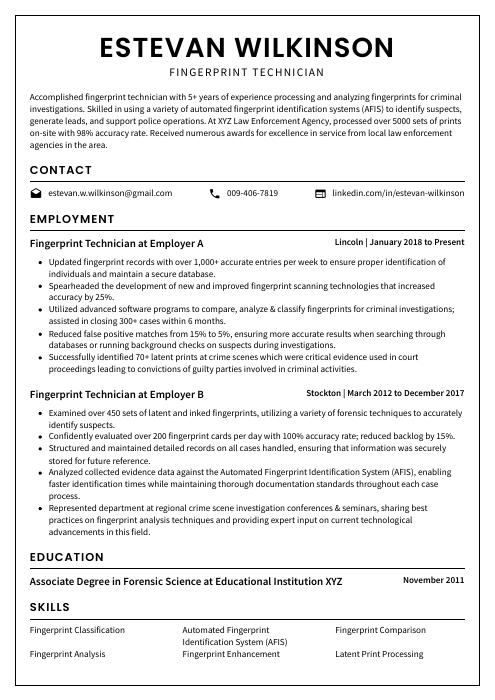 Cormorant
Cormorant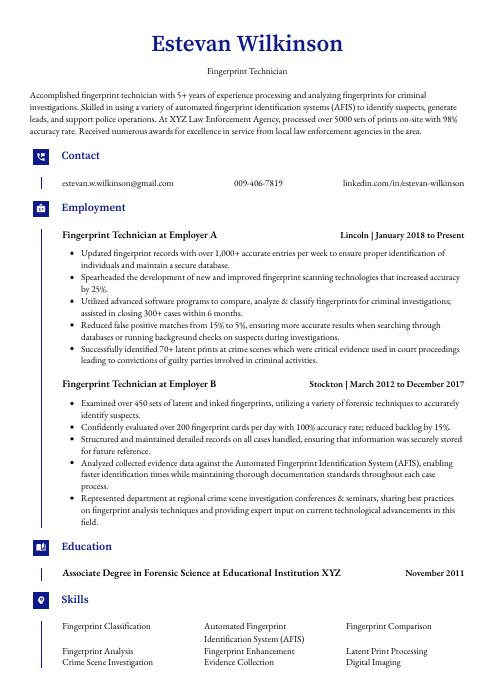 Gharial
Gharial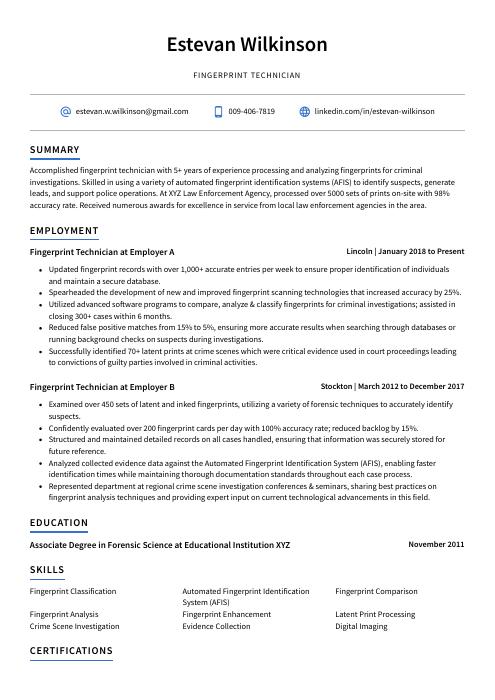 Axolotl
Axolotl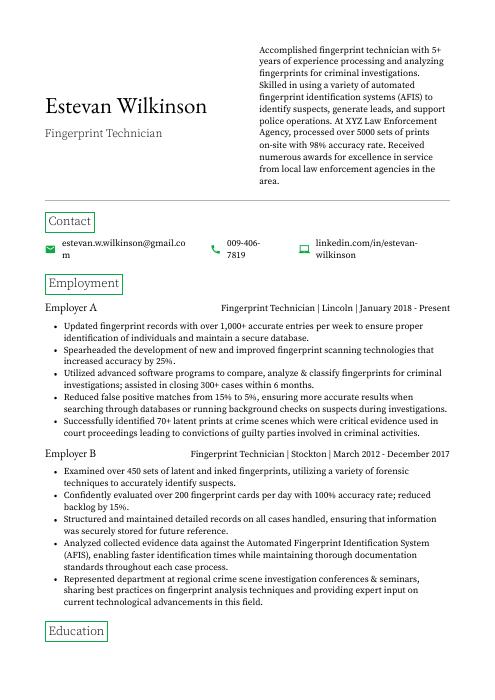 Quokka
Quokka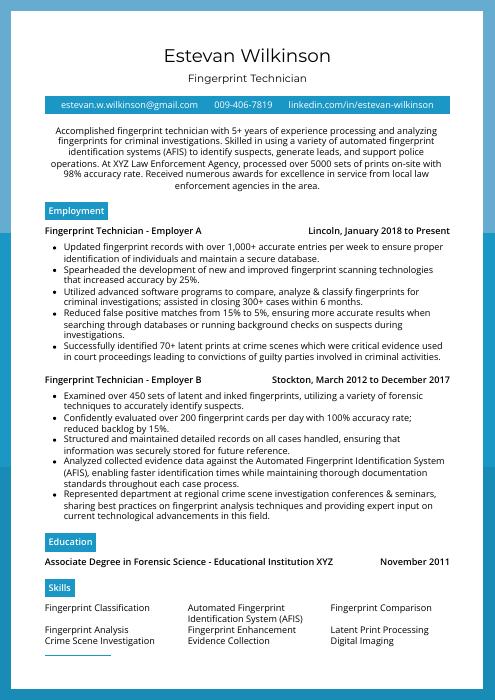 Rhea
Rhea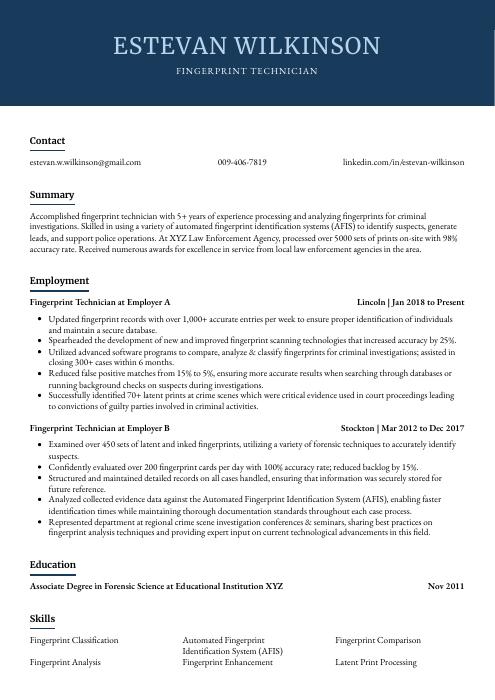 Bonobo
Bonobo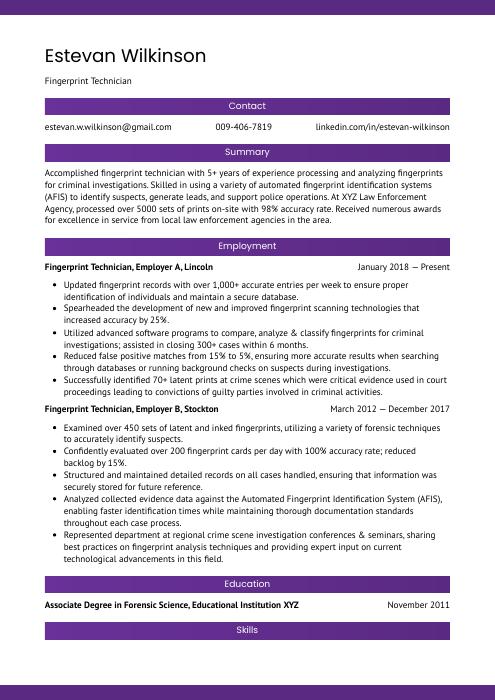 Jerboa
Jerboa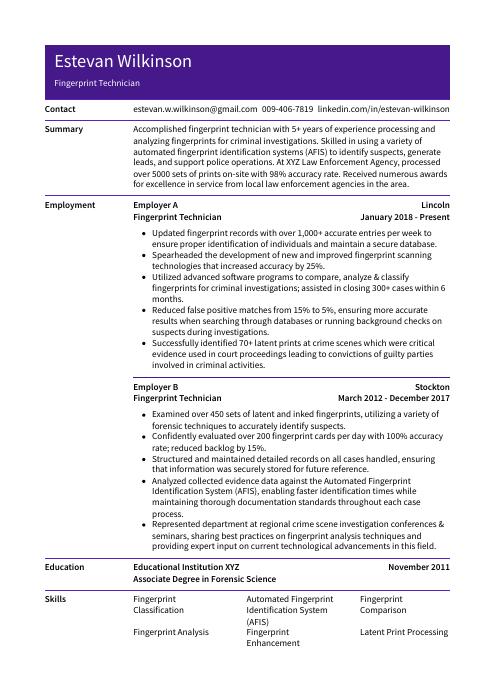 Pika
Pika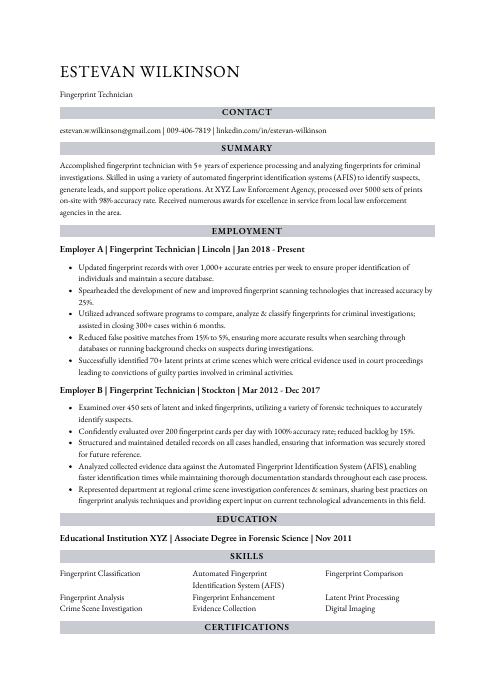 Numbat
Numbat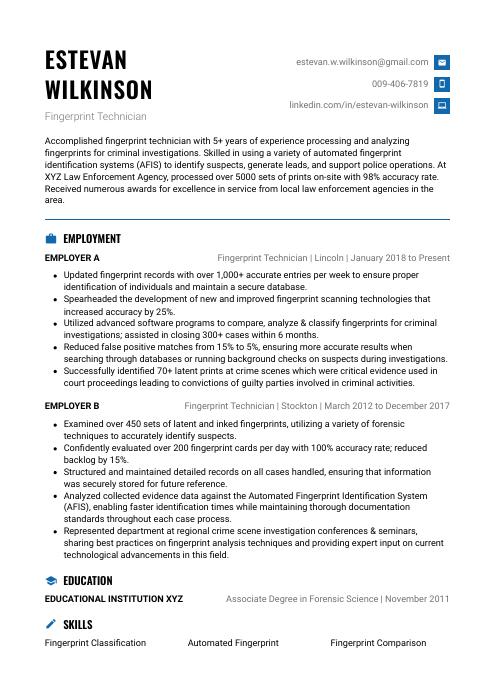 Echidna
Echidna Rezjumei
Rezjumei
